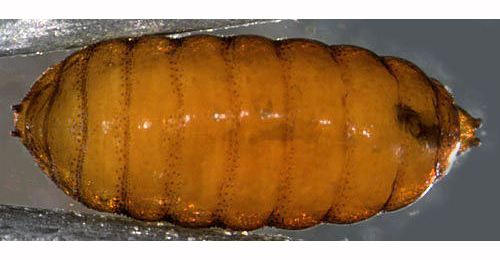|
||||||
| Agromyza
mobilis Meigen, 1830 [Diptera: Agromyzidae] |
||||||||||||||||||||||||||||||||||||||||||||||||||||||||||||||||||||||||||||||||||||||||||||||||||||||||||||||||||||||||||||||||||||||||||||||||||||||||||||||||||||
|
Agromyza
mobilis Meigen, 1830. Syst. Beschr. 6: 169 |
||||||||||||||||||||||||||||||||||||||||||||||||||||||||||||||||||||||||||||||||||||||||||||||||||||||||||||||||||||||||||||||||||||||||||||||||||||||||||||||||||||
|
Leaf-miner: Long upper-surface corridor usually containing several larvae that graze shoulder to shoulder from the leaf tip downwards. Pupation outside the mine. Mines and larvae are indistinguishable from those of A. nigrella (Bladmineerders van Europa). Larva: The larvae of flies are leg-less maggots without a head capsule (see examples). They never have thoracic or abdominal legs. They do not have chewing mouthparts, although they do have a characteristic cephalo-pharyngeal skeleton (see examples), usually visible internally through the body wall. Larval mandibles with two teeth; posterior spiracles far apart (Bladmineerders van Europa). Puparium: The puparia of flies are formed within the hardened last larval skin or puparium and as a result sheaths enclosing head appendages, wings and legs are not visible externally (see examples). The puparium is illustrated in Bladmineerders van Europa.
Hosts in Great Britain and Ireland:
Hosts elsewhere:
Time of year - mines: June. Time of year - adults: Currently unknown. Distribution in Great Britain and Ireland: Widespread in Britain including Derby (Miller's Dale), Stafford (Newcastle-under-Lyme), Northumb. (Wooler), Yorkshire (Burely in Wharfedale), Perth (Spencer, 1972b: 33); Warwickshire (Brinklow) (Robbins, 1991: 135) and Anglesey, Cambridgeshire, Cardiganshire, Carmarthenshire, Denbighshire, East Norfolk, East Suffolk, Elgin, Glamorgan, Huntingdonshire, Middlesex, North Devon, North Hampshire, North-east Yorkshire, Nottinghamshire, Oxfordshire, Pembrokeshire, South-east Yorkshire, South-west Yorkshire, Stafford, Surrey and West Norfolk (NBN Atlas). Distribution elsewhere: Widespread and common in continental Europe including Denmark, Finland, Norway, Sweden, Holland, Italy (Spencer, 1976: 123), Belgium (Scheirs, de Bruyn and von Tschirnhaus, 1996), Germany (Spencer, 1976: 546), Czech Republic, Estonia, French mainland, Hungary, Latvia, Lithuania, Poland, Slovakia, Spanish mainland, Sweden and Switzerland (Fauna Europaea). Also recorded in Japan by Sasakawa (1961), although the accompanying illustration of the genitalia suggests that a [different but] closely related species is involved (Spencer, 1990). NBN Atlas links to known host species: British and Irish Parasitoids in Britain and elsewhere:
|
|
|
|
| External links: | Search the internet: |
|
Biodiversity Heritage Library Bladmineerders van Europa British leafminers Encyclopedia of Life Fauna Europaea NBN Atlas NHM UK Checklist |
Find
using Google Find using Google Scholar Find images using Google |
| Last updated 07-Oct-2019 Brian Pitkin | ||

